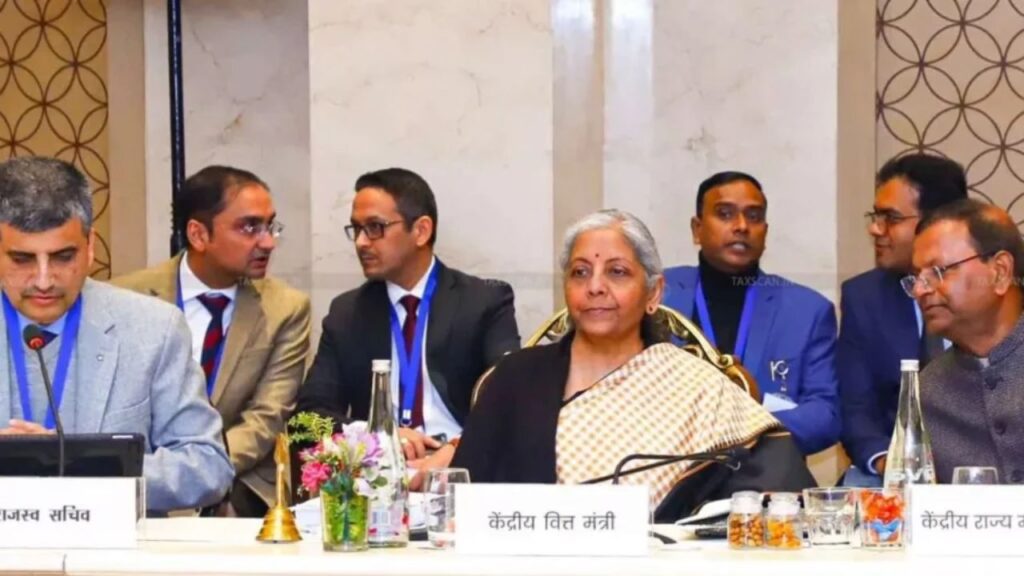GST Council Meeting: The 56th GST Council meeting, chaired by Union Finance Minister Nirmala Sitharaman, commenced in New Delhi on Wednesday, September 3. Scheduled to continue over two days, the council is expected to discuss sweeping reforms in India’s Goods and Services Tax (GST), including rationalisation of tax slabs, sharp rate cuts for common-use goods, and structural simplifications aimed at easing compliance for businesses.
These reforms follow Prime Minister Narendra Modi’s Independence Day announcement of next-generation GST changes, widely hailed as the largest indirect tax overhaul since its introduction in July 2017. The council, which includes representatives from 31 states and Union Territories, is examining a proposal to simplify GST rates into three broad categories: 5%, 18%, and 40%, replacing the current four-tier structure of 5%, 12%, 18%, and 28%.
Proposed GST Rate Rationalisation
The Centre’s proposal focuses on three key pillars:
- Structural reforms: Correcting inverted duty structures, resolving classification disputes, and ensuring predictability.
- Rate rationalisation: Reducing taxes on common-use and aspirational goods, consolidating slabs, and subsuming the compensation cess.
- Ease of living: Streamlining registration, returns, and refund processes for businesses, especially small enterprises.
Under the proposed changes:
- 99% of items in the current 12% slab would move to 5%.
- 90% of goods currently taxed at 28% would shift to 18%.
- Sin and luxury items, including tobacco, pan masala, large cars, and lotteries, would attract a 40% rate.
Sector-Wise Highlights
| Sector | Items Likely Affected | Current vs Proposed GST |
|---|---|---|
| Food & Dairy | Butter, cheese, fruit juices, packaged foods | 12% → 5% |
| Consumer Durables | TVs, ACs, refrigerators, washing machines | 28% → 18% |
| Textiles | Synthetic yarn, carpets, woven fabrics | 12% → 5% |
| Automobiles | Small petrol cars, hybrid vehicles | 28% → 18% |
| Luxury & Sin Goods | Cigarettes, pan masala, big cars, casinos | 28%-cess → 40% |
| Renewable Energy | Solar cookers, solar water heaters, fuel cell vehicles | 12% → 5% |
| Health & Insurance | Individual health and life insurance | 18% → Exempt |
The proposal also seeks to eliminate numerous classification disputes that have plagued GST over the past eight years, particularly in the food and automotive sectors, for example, roti versus parotta, fryums versus papad, and biscuit versus chocolate.
Compliance Simplification
A significant feature of the reforms is the focus on ease of doing business:
- Registration and Returns: Pre-filled returns, automated filing, and faster refund processing for exporters and those affected by inverted duty structures.
- Refunds: Automated refunds and time-bound processing, reducing delays and manual intervention.
- Technology Driven: The new processes aim to support small businesses and startups in managing compliance efficiently.
Finance Minister Sitharaman emphasized ahead of the meeting that these reforms would create a transparent economic environment, benefiting micro, small, and medium enterprises while easing compliance burdens.
Revenue Implications
While the GST overhaul is designed to benefit consumers and promote domestic demand, states have raised concerns over revenue losses.
- The 18% slab currently contributes 73% of GST revenues, while 28% contributes 12%.
- Rationalisation could result in an initial revenue loss of ₹70,000–80,000 crore, with the insurance sector exemption alone estimated at ₹9,900 crore annually.
- States project losses ranging from ₹85,000 crore to ₹2 lakh crore, urging compensation mechanisms and potential levies on sin and luxury goods.
Experts suggest that while there may be short-term revenue dips, long-term gains from higher compliance and increased consumption could offset losses. SBI Research estimates that GST reforms could boost India’s GDP by 60 basis points over the next year while easing retail inflation by 20-25 basis points.
Impact on Consumers and Industries
- Cheaper Goods: Essentials like toothpaste, soaps, butter, and packaged foods will likely see GST reduced to 5%. Consumer electronics and white goods such as refrigerators and ACs would move to the 18% bracket.
- Luxury Goods Taxed Higher: Large cars, luxury electric vehicles, and select high-end two-wheelers could fall under the 40% bracket.
- Boost for Sectors: Textiles, consumer goods, and small automobiles stand to benefit significantly. EV makers, however, may face higher taxes for premium vehicles.
Challenges Ahead
The success of GST 2.0 hinges on securing consensus among all states. Opposition-led states have demanded compensation for revenue losses and assurances that tax benefits reach consumers rather than creating windfall profits for select companies.
The council’s decisions are particularly timely, ahead of the festive season and in the backdrop of global trade challenges such as US import tariffs on Indian goods. The reforms aim to strengthen domestic demand, promote investment, and simplify India’s tax system while maintaining revenue neutrality through a 40% “sin and luxury” tax band.
The 56th GST Council meeting marks a pivotal moment for India’s indirect tax landscape. If approved, the proposed reforms, from simplified slabs to compliance-friendly processes, could ease business operations, reduce prices for consumers, and create a more predictable tax environment, potentially offsetting global economic shocks. The council is expected to announce its decisions after deliberations conclude on September 4, making this one of the most consequential GST meetings since 2017.
The meeting will continue tomorrow, with final decisions and official notifications expected thereafter.

